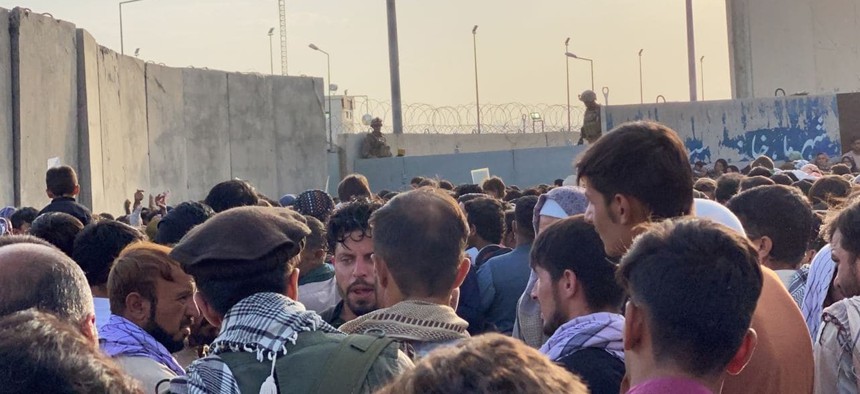
People who want to flee the country continue to wait around Hamid Karzai International Airport in Kabul, Afghanistan on August 24, 2021. Haroon Sabawoon/Anadolu Agency via Getty Images
Kabul Evacuee With Potential ISIS Ties Detained at Qatar Base
Up to 100 evacuees have been flagged for further scrutiny during the more comprehensive screening they received at their first stop after Afghanistan.
Security screeners at Al Udeid Air Base in Qatar have detected that at least one of the Afghans who was evacuated from Kabul Airport has potential ties to ISIS, a U.S. official confirmed to Defense One.
Moreover, the Defense Department’s Automated Biometric Identification System has flagged up to 100 of the 7,000 Afghans evacuated as prospective recipients of Special Immigration Visas as potential matches to intelligence agency watch lists, a second official said.
At least 6,000 fleeing Afghans have been evacuated to Al Udeid and thousands more have been flown to other temporary staging bases throughout the Middle East and Europe by U.S. military aircraft. At those bases, Customs and Border Patrol screeners are checking evacuees’ IDs and biometric data against law enforcement databases, the first official said.
Ultimately, thousands of those Afghans will come to the United States, where they will be initially housed at several military bases, such as Fort Bliss in Texas, Fort McCoy in Wisconsin and Fort Lee in Virginia.
“There’s certainly been a number of them” who triggered alerts, requiring agents to pull those evacuees aside for further screening, the first official said. In most cases, those Afghans—many of whom have already been vetted through the special immigrant visa process—were cleared by follow-on screening.
But in at least one case, the evacuee “looks like a potential member of ISIS,” the first official said. “They’re still working that through.”
On a Tuesday call with reporters, a senior administration official said that Afghans evacuated to third-party countries are going through “robust security processing” before coming to the United States.
“That process involves biometric and biographic security screenings conducted by our intelligence, law enforcement and counterterrorism professionals who are working quite literally around the clock to vet all these Afghans before they’re allowed into the United States,” the senior administration official said.
For the first few days after Kabul fell on Aug. 15, there were a limited number of U.S. screeners at Hamid Karzai International Airport working to vet hundreds, then thousands of evacuees. To date, the U.S. military and chartered aircraft have flown out more than 63,000 Americans, Afghans, and allied partners fleeing the Taliban’s takeover of Afghanistan, in one of the fastest and largest air evacuation operations in the military’s history.
But it wasn’t just the sheer numbers of people that was the challenge. The agents were struggling with old vetting systems and could not integrate all of the information needed, such as the Defense Department’s biometric database information, said a second official who is familiar with the vetting process.
“CBP on the ground has old tech and they don’t know how to use it, integrate it,” the official said. “And there’s not enough people to process” all of the evacuees.
It can take up to an hour for the system to crunch the data and tell a screener whether a person is “green”—cleared—or “red” and a potential security risk, which has been part of the reason for large backlog of evacuees stuck at bases now.
“The bottom line is the system is working, but slow in the process,” the official said.
In the last few days, the U.S. military and civilian airlift operation has gained pace, flying out 21,600 people on Tuesday alone. Those operations are racing against an Aug. 31 deadline to get all troops out.
While most of the security alerts have occurred at Al Udeid, the massive airlift operation has expanded to the extent that it’s possible there are Afghans with potential terror ties getting flagged at other bases.
“I can’t rule it out,” the official said.
Jacqueline Feldscher contributed to this report.




